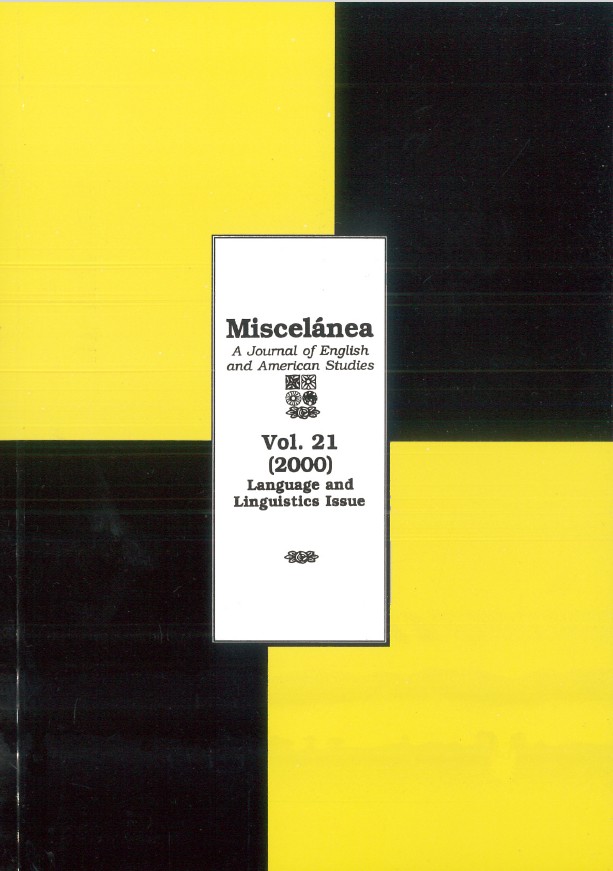Prolegómenos a la elaboración de un inventario de rasgos sinemáticos del verbo del inglés antiguo
DOI:
https://doi.org/10.26754/ojs_misc/mj.200011002Palabras clave:
sintaxis semántica, léxico FLM, derivación léxica, causalidad, caso, impersonalidad, pragmáticaResumen
A través del análisis detallado de las definiciones de significado de distintos conjuntos semánticos de verbos del inglés antiguo y de sus patrones de complementación, propondré una reconstrucción preliminar de un conjunto básico de rasgos de sintagma, es decir, parámetros sintácticos y semánticos que operan en todo el léxico en las distintas áreas de significado. Estos rasgos se dividen en tres tipos básicos: obligatorios, opcionales y contextuales. Mediante la adición de un componente morfológico, T propondrá algunas posibles aplicaciones del modelo semántico-sintáctico de Faber y Mairal (1988) al análisis del vocabulario anglosajón.
Mostras las descargas
Referencias
ALLEN, C. L. 1986. “Reconsidering the History of Like”. Journal of Linguistics 22: 375-409. DOI: https://doi.org/10.1017/S0022226700010847
COLE, P. 1986. “The Grammatical Role of the Cause in Universal Grammar”. International Journal of American Linguistics 49: 115-133. DOI: https://doi.org/10.1086/465778
DÍAZ VERA, J. E. (forthcoming) “The Development of Causation in Old English and its Interaction with Lexical and Syntactic Processes”. Cuadernos de Investigación Filológica 25-26. DOI: https://doi.org/10.18172/cif.2217
ELMER, W. 1981. Diachronic Grammar: the History of Old and Middle English Subjectless Constructions. Tübingen: Max Niemeyer. DOI: https://doi.org/10.1515/9783111346120
FABER, P. and R. MAIRAL. 1998. “Towards a Semantic Syntax”. Revista Canaria de Estudios Ingleses 36: 37-64.
FABER, P. and C. PÉREZ. 1993. “Image Schemata and Light: a Study in Contrastive Domains in English and Spanish”. Atlantis 15: 117-134.
FISCHER, O. and F. VAN DER LEEK. 1983. “The Demise of the Old English Impersonal Construction”. Journal of Linguistics 19: 337-368. DOI: https://doi.org/10.1017/S0022226700007775
KYTÖ, M. 1996. Manual to the Diachronic Part of the Helsinki Corpus of English Texts: Coding Conventions and Lists of Source Texts. Helsinki: University of Helsinki.
LASS, R. 1994. Old English: A Historical Linguistic Companion. Cambridge: Cambridge U. P. DOI: https://doi.org/10.1017/CBO9780511621000
LEHMANN, W. P. 1974. Proto-Indo-European Syntax. Austin: University of Texas.
LOWE, P. 1972. “Germanic Word Formation”. In Coetsem, F. van and H. L. Kufner. (eds.). Towards a Grammar of Proto-Germanic. Tübingen: Max Niemeyer: 211-238.
NEDYALKOV, V. P. and G. G. SILNITSKY. 1978. “The Typology of Morphological and Lexical Causatives”. In Kiefner, F. (ed.). Trends in Soviet Theoretical Linguistics. Dordrecht/Boston: 7-30.
PENHALLURICK, J. M. 1975. “Old English Case and Grammatical History”. Lingua 36: 1-29. DOI: https://doi.org/10.1016/0024-3841(75)90024-8
POKORNY, J. 1959-1969. Indogermanisches etymologisches Wörterbuch (2 vols.). Bern and Munich: Francke Verlag.
SEEFRANZ-MONTAG, A. von. 1984. ““Subjectless” Constructions and Syntactic Change”. In Fisiak, J. (ed.). Historical Syntax. Austin: University of Texas: 521-553. DOI: https://doi.org/10.1515/9783110824032.521
SWEETSER, E. 1990. From Etymology to Pragmatics: Metaphorical and Cultural Aspects of Semantic Structure. Cambridge: Cambridge U.P. DOI: https://doi.org/10.1017/CBO9780511620904
Descargas
Publicado
Número
Sección
Licencia
Derechos de autor 2000 Javier E. Díaz Vera

Esta obra está bajo una licencia internacional Creative Commons Atribución-NoComercial 4.0.


